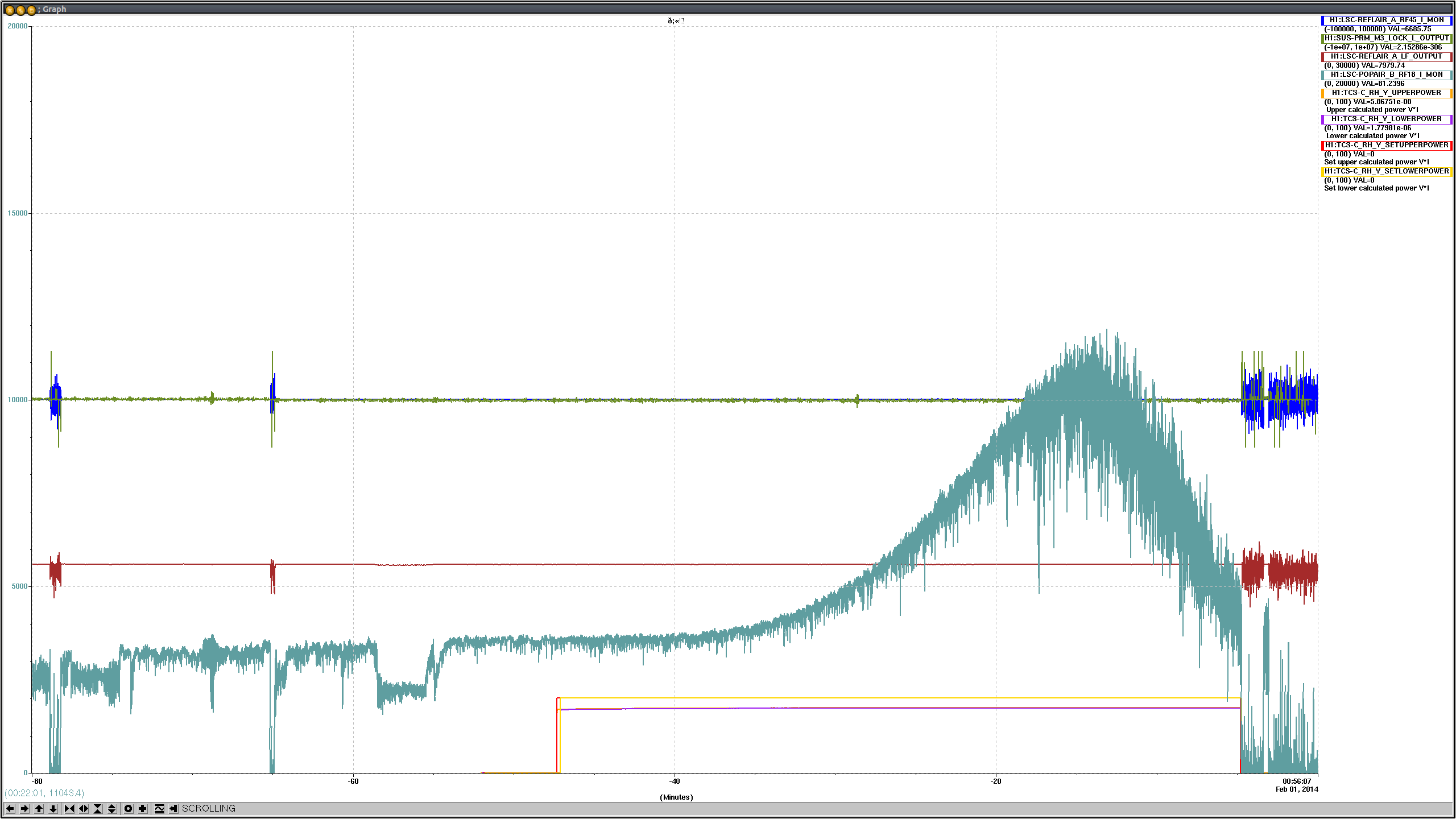Stefan, Kiwamu
The PRMI lock is now quite solid. After we engaged a dither alignment system for ITMY, we turned on the ring heater on ITMY with a hope it is going to improve the mode matching.
- We set the modulation frequency back to 9099471 Hz which is the nominal value. This was for making sure that the separation of MICH and PRCL is good in REFLAIR_RF45. Although, we didn't do any quantitative assessment. So we have to revisit this.
- Both stages of BS-ISI and stage2 of ITMY-ISI were turned off because they were found to be too loud at low frequencies around 0.5 Hz and also at around 10 Hz (for some reason). Disabling them made the PRY noise quitter and the length RMS improved by a factor of 2 or 3.
- We successfully locked the PRMI with the sideband resonant with the settings shown in the attached screenshot.
- We found four oscillations very close to each other at around 300 Hz which are believed to be the BS wire violin modes. Two of them were so big and 6 orders of magnitude bigger than the noise floor.
- We put a double notch filter in LSC-MICH and PRCL filter banks. This let the mode ring down slowly.
- Also, at the same time we saw a power drop over a time scale of 2 minutes which seemed to be correlated to with the peak height of the violin modes. This behavior went away after the notch filters were installed.
- The PRMI lock was so stable that it did not spontaneously unlock.
-
We set up an audio output path in LSC-DARM and used Chris's cool script, rockifo to listen to the sound of PRCL and MICH.
- It is available in /ligo/home/christopher.wipf/Public/bin
- For example, rockifo H1:LSC-DARM_OUT_DQ 16384 100
- We imported LLO's dither alignment stuff, but we realized that it only dithered the common mode of the power recycling cavity while we wanted to stabilize the ITMY angle drift. So we decided not to use it.
- We temporarily disconnected the cable for the ITMY green transmitted power and instead plugged in QMON of POPAIR_B_RF18. We used an SR560, AC coupled at 0.1 Hz with a gain of 5000 to whiten the signal.
- We then used the Y-arm dither alignment system to keep ITMY well aligned. We chose 1.7 and 2.4 Hz for pitch and yaw excitations respectively.
- We could close both pitch and yaw loop, probably with a UGF of 0.1 Hz for both.
- We turned on the ring heater at around 00:08 in local time with 10 W in both upper and bottom heaters of ITMY.
Below are Aiden's plot and remarks: I've attached some plots of thermal lens vs time for a RH running at 1W. The slope of the linear section, dS/dt, from t = 2000s to 3000s is 6.75E-9 diopters per second per Watt. The final steady-state defocus, S_steady, is about 13.75E-6 diopters. In the initial state, it takes t_S_steady1, 2037 (= 13.75E-6/6.75E-9) seconds to reach assuming an immediate and linear increase in defocus, t_S_steady1 = S_steady/dS/dt .... In other words, the 20W/2.1x = 9.4W should give the maximum mode matching after 2037s of linear increase in defocus AND in the steady-state.
I modeled the 18MHz sideband buildup in the H1 PRMI as a function of ITMY Rc to see how it compared to the observations made recently. The attached plot shows POP 18MHz I and Q signals over ITMY Rc. The leftmost side of the plot is for the measured value of ITMY Rc from the nebula page, with no ITMY substrate lens, and the measured value of ITMX Rc from the nebula page with an -80km substrate lens. MICH was locked using REFL45Q and PRCL was locked using REFL45I. The POP demod phase was tuned to minimize Q-phase signal at the starting ITMY Rc value. The input carrier power in the model is 10W, the 9MHz modulation depth is 0.1, and the 45MHz modulation depth is 0.07. No optics after the PR2 transmission were included in the model.
As expected, the buildup increases as PRX and PRY become better matched. In the model, the buildup increases to a maximum of around a factor of 10 from the initial value. This is a much larger increase than was seen in the experiment. This could be because the model does not include clipping at the BS, which would increase as the beam sizes increase (see lower panel of the plot). Also, it is possible that ITMY has a non-thermal substrate lens (no measurement data is available for this), putting it closer to ITMX in the no-ring-heater state. Beyond the maximum, the PRMI quickly becomes unstable. This may explain the lock loss in the experiment past the maximum POP18 buildup (though many other things could too).








 so I'll go ahead and add a new filter called "cts2uW" in the SUM_OUTMON paths to give the outputs in uW incident on the PDs.
so I'll go ahead and add a new filter called "cts2uW" in the SUM_OUTMON paths to give the outputs in uW incident on the PDs.



